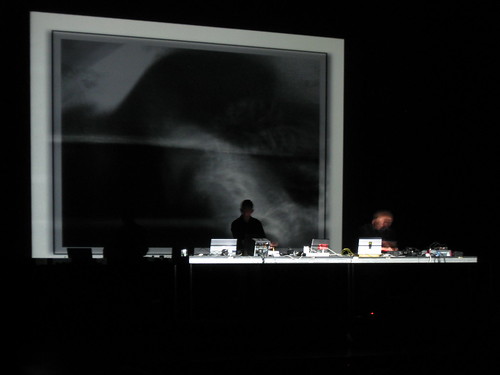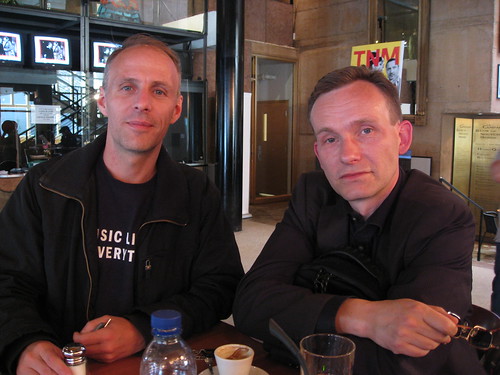CDM has ongoing coverage from the Mutek festival; see more dispatches at events.createdigitalmusic.com. Liz talks to A/V duo Rechenzentrum for CDM — and there’s a bit of a revelation at the end of the interview. -Ed.
Rechenzentrum, which means “data processing center” in German, is a Berlin-based duo who create live audio-visual performances by combining austere film visuals with their own brand of minimal techno, fusing elements of jazz, dub, and early industrial. Marc Wieser handles the music half while Lillevan navigates the visual landscape. Their 2003 DVD release Director’s Cut, originally out on Mille Plateaux, went on to win the Ars Electronica prize. Marc and Lillevan sat down with us after their sound check for A/Visions 2 at Mutek 2008.
Liz: What goes on in a live Rechenzentrum performance?
Lillevan: I do the video; Marc does the music. The video is live in the sense that I determine which image gets shown at which second, but obviously I’m not creating the image in real time because I’m not really interested in that. Real-time-created video usually looks pretty “blocky,” and I don’t really like it that much. It’s a mixture of pre-recorded video coming off a hard disk and live stuff reacting off of Marc’s music. But we’re not connected by any kind of MIDI connections or sound analysis. I just listen to his music and create stuff based on that. It’s a connection between our persons and not between our computers.
Marc Weiser: This way it’s improvised, for sure.
L: [The performance project is] called Silence like the last DVD, so it’s a live re-working of [the A/V album] introducing new elements that Marc has created in the last month. It’s based on the last DVD but it’s an updated, newer version.
M: It’s not 100% the same every time.
In the press release for Silence you said you consider video as an instrument. What do you mean by that?
L: We wanted to make sure people didn’t misunderstand our project — as in one guy’s doing music and there’s visuals accompanying music. We wanted to say it’s equally important; [it’s] media being presented to the public. It’s their responsibility to put these two media together in any way they see fit or to ignore one and focus on the other. And so we said that sound can also be a color, music can be a color, music can be a “filmic” narrative element in the same way as film can be an instrument. That’s where that quote came from.
How did you two come together to work with video and music?
M: Totally by accident—we met in a squatted house around 11 years ago in Berlin—we had a club there and were both working there. After that we decided to work together. It wasn’t planned.
L: We were also part of an eleven-piece live drum and bass band which was a lot of fun. But we also realized how tiring it could be with eleven people who have very different focuses in life, willing to dedicate various amounts of time to this. We were willing to take more risks, willing to put stuff in Marc’s car, drive off somewhere, play somewhere, and see what happens — and that’s easier to do when you’re two people than eleven. Then we started actually getting gigs in Berlin for techno parties, where the promoter would have some pretentions to be artistically inclined and wanted to have a chill-out room with some more interesting stuff than just “four [on] the floor,” So they asked us to do it because our influences in those days were incredibly varied. We would play for hours and hours just mixing as much material as possible. Like Lee Perry said, the mixing desk is the instrument—for me it was video, lots of TVs plugged in and stuff. And we played everything—the whole history of experimental media mixed to layers over more layers. And over the years we whittled that down from 11-hour shows to a one hour performance. There was never a concept where we sat down and thought, “What shall we do? Let’s try this.” It kind of evolved over the years.

Along the lines of evolution, it seems that in electronic music there’s been an increasing focus on integrating music with visuals–although within the history of art it’s had a long history in its own right. Why do you think this relationship of music to to video has become so important of late?
L: The history is very long. Hundreds of years ago Leonardo da Vinci tried to make pianos that also create light with candles and colored paper, so this idea of using various media is nothing new. Warhol was doing it in the 60s, by projecting his own film Chelsea Girls on the Velvet Underground as they played. I always found it interesting with him that when he noticed the audience was starting to like it, he would get irritated and immediately change the films. It wasn’t supposed to make people feel lounge-y and happy; it was supposed to be irritating. We never had a concept when we started; it was just that Marc was a musician and I’m a filmmaker, so we said let’s see if these two things work.
Over the years I’ve seen some things where I was surprised that some musicians would allow video [projection] that they hadn’t seen before by artists they’d never met before. At some video festivals I’ve seen stuff where I really felt that the videos destroyed the music, and I’ve felt sorry for the musicians when that happens.
Rechenzentrum at Mutek 2008 from Create Digital Media on Vimeo.
M: We were never interested in synchronization; maybe it’s a powerful thing that we never thought about things like that. You have to be “this is your part,” “this is [my] part,” be as good as you can, bring it onstage. Sometimes it’s good, sometimes not.
L: It’s interesting for us to watch how people have tried to plan their careers within a certain genre—they go to festivals and see what’s happening now and try to order their set to that. Without trying to sound too punk-ish or rebellious, we were never like that, at the risk of getting less shows at times or more shows other times. You’d see people would be like, “Oh, you’re not really into tech and you’re not programming all your own software,” and we just never did that. I mean now I’ve gotten into programming Jitter and Max/MSP in the last years, and even that bores me and I get someone else to do it for me—a student of computer arts in Serbia, because I just have no interest in programming whatsoever.
I think a lot of what we did was we actually, like, irritated people, as well — it’s in our nature to not always give people what they want because it can be very clinical and very boring. We were invited a lot to play, for example, in museums, museum openings and such. It was very interesting for me to look “OK, why is a museum asking us to do this?” and it was quite obvious that the museum needs street credibility, [needs] youth culture … to get people to actually visit the museums and buy tickets so they get more money. So we thought, in this case let’s not be really arty. Let’s give them really asocial hard techno. And then at other times we’d be invited to play in really techno places and we’d do remixes of Miles Davis, which earned us lots of Coca-Cola cans being thrown at us. And it wasn’t about trying to be bad boys. It was just trying not to be too precious about your career and “oh, don’t make a mistake here, there’s an important curator in the audience, let’s not make a mistake tonight.” You can do that, and maybe you’ll have a successful career doing that, but I find it very boring.
I see that the Silence DVD is out on Weiser music; why did you start your own label now?
M: We were unlucky with all our labels, more or less. The first they didn’t understand what we were doing — the first CD only had music, the second we had only one visual track, the third on Mille Plateaux… it takes so much time from creating the music and the visuals until the release — years. I decided [to do] it by myself, because all the labels don’t exist any more. Kitty Yo, Mille Plateaux doesn’t exist any more. All the other labels in Berlin where we have contacts –- we haven’t talked to them but it’s obvious that they have their own problems, in a way, because they really don’t know what to release. It’s too risky for them. We are not a rock band, it’s not folk, it’s not techno, it’s not club, it’s not art enough, so we ended up sitting beside jazz.
Do you want to tell us about any new projects you’re working on?
L: We’ve got lots of exciting projects coming up, but the sad [news] is that this is one of our last shows as Rechenzentrum—we’re splitting up!
Rechenzentrum at Mutek 2008 from Create Digital Media on Vimeo.
The lucky attendees at Mutek’s A/Visions 2 on Thursday experienced sets by Freida Abtan
Németh + Hess, Nokami + Sans Soleil as well as Rechenzentrum’s.
Photos by Andrew Lochhead
